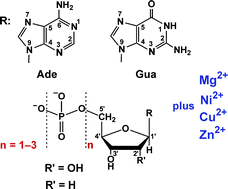Effect of the riboseversus2′-deoxyribose residue on the metal ion-binding properties of purine nucleotides
Abstract
The interaction between metal ions and

* Corresponding authors
a
Institute of Inorganic Chemistry, University of Zürich, Winterthurerstrasse 190, Zürich, Switzerland
E-mail:
roland.sigel@aci.uzh.ch
b Department of Bioinorganic and Biomedical Chemistry, Faculty of Chemistry, University of Wrocław, F. Joliot Curie 14, Wrocław, Poland
The interaction between metal ions and

 Please wait while we load your content...
Something went wrong. Try again?
Please wait while we load your content...
Something went wrong. Try again?
A. Mucha, B. Knobloch, M. Jeżowska-Bojczuk, H. Kozłowski and R. K. O. Sigel, Dalton Trans., 2008, 5368 DOI: 10.1039/B805911J
To request permission to reproduce material from this article, please go to the Copyright Clearance Center request page.
If you are an author contributing to an RSC publication, you do not need to request permission provided correct acknowledgement is given.
If you are the author of this article, you do not need to request permission to reproduce figures and diagrams provided correct acknowledgement is given. If you want to reproduce the whole article in a third-party publication (excluding your thesis/dissertation for which permission is not required) please go to the Copyright Clearance Center request page.
Read more about how to correctly acknowledge RSC content.
 Fetching data from CrossRef.
Fetching data from CrossRef.
This may take some time to load.
Loading related content
